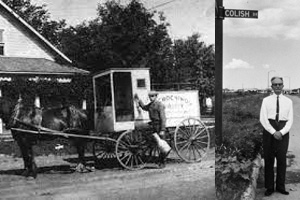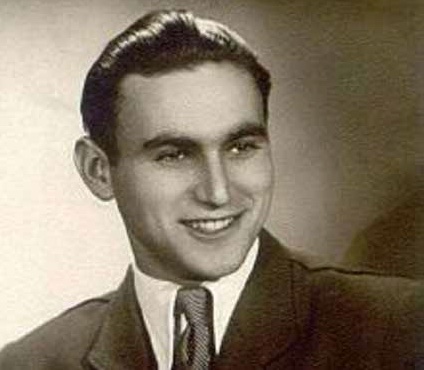Features
Isaac Colish and the Jews of West Kildonan

Introduction: Further to the list of Manitoba synagogues which you can find elsewhere on this website (http://jewishpostandnews.ca/8-features/987-a-list-of-all-winnipeg-synagogues-that-ever-existed), we were intrigued by a listing of a “Kildonan Talmud Torah”. There was no street given for the location of that particular Talmud Torah so, as we have done so many times in the past, we contacted Stan Carbone of the Jewish Heritage Centre to see whether he could provide some further information about the Kildonan Talmud Torah.
As usual, Stan responded with some very useful information about not only that Talmud Torah, but the history of Jewish dairy farmers in the Kildonan area. I’m sure that as you read Stan’s article, you’ll recognize many of the names he mentions as having been involved in the dairy business:
The settlement patterns of Manitoba Jews straddled rural and urban socio-economic lifestyles. This was the case of the dairy farmers who settled in the West and Old Kildonan municipalities. These included the Tennehouses, Fromsons, Chochinovs, Filkows, Zipurskys, Finkles, Bercovitches, Pudavicks, Greenbergs, Walshinskys (Walshes), and Greenbergs, who for many years supplied Winnipeg with milk, cream, and cheese. Ze’ev Walshinsky (Walsh) came to Manitoba in the early 1900s, bought a farm which turned into a business and delivered milk to the North End. One of his sons, Harry, became a celebrated criminal lawyer. In the 1910s, the Filkows, sold their dairy products to the Crescent Creamery at wholesale prices and by the 1920s directly to peddlers.
Louis Rosenberg notes that by 1911 300 Jews lived in West Kildonan. This total declined to 100 in 1941. But following the war the Jewish presence in West Kildonan increased significantly and by 1961, 6,133 Jews lived in Winnipeg, a figure surpassed only by the 6,693 living in Winnipeg North.
In 1912, the dairy farmers built an Orthodox synagogue on Lillian Avenue, a two-room Talmud Torah that offered after-school Hebrew lessons and bar mitzvah classes, and a cemetery that is now part of the Hebrew Sick Benefit Cemetery. As a result of internal dissension that Allan Levine identifies as “disputes about prayer honours,”a second synagogue was established in 1915 on Newton Avenue, which lasted only until 1919. The building was sold to the Zipurskys who moved it closer to McPhillips and converted it into a grocery store. The Lillian Avenue synagogue, which was rebuilt following a fire in 1936, closed in 1949, and its assets were transferred to the Jewish National Fund.
Allan Levine noted that from the West Kildonan Jewish community there emerged Isaac Colish who was to establish a distinguished political career. Born in Shvenchenis, Lithuania, Colish came to Winnipeg in 1907, from England where he had operated two grocery stores. He had enough financial resources to purchase a horse and rig and delivered second-hand furniture. Shortly thereafter he invested in a shack, stable and land north of Main. In subsequent years, Colish owned grocery stores.
In 1913 Colish was elected to the Kildonan municipal council by acclamation. After the municipality divided into West, East and North, Colish was elected to the West Kildonan Council.
In 1916, Colish became the first Jewish police magistrate in Manitoba. He used his new found powers to defend the interests of Jewish dairy farmers. Interviewed in 1972, Colish noted, “I protected [the Jewish Community]. They used to like me in Kildonan…At that time, the Jews had cattle, and people used to bring them into [the] pound and then [the owner] was charged twenty dollars, thirty dollars [as a pound fee to get them back]…I stopped that.
During the 1919 Winnipeg General Strike, Colish, who at the time was Police Magistrate and was expected to uphold the law, sympathized with labour. In one instance he allowed for a meeting of strikers at Kildonan Park, notwithstanding a warning from the park superintendent who declared that such meetings could not take place on city property. In addition, Colish proceeded to “pass his cap” and raise funds for the unemployed.
In recognition of his service to the people of West Kildonan, Colish had a street named after him in the Garden City area.
Isaac Colish died in 1977 at the age of 100.
Bibliography
Colish, Isaac. Interviewed by Sam Donen, April 14, 1972, Tape no.61
Winnipeg: Jewish Historical Society Oral History Collection
(Jewish Heritage Centre)
Jewish Life and Times: Personal Recollections: The Jewish Pioneer Past on the Prairies.
Winnipeg: Jewish Historical Society of Western Canada, 1993.
(Includes excerpts from interviews with Isaac Colish and Jack Filkow).
Levine, Allan. “Coming of Age: A History of the Jewish People of Manitoba”.
Winnipeg: Heartland Associates, 2009.
Rosenberg, Louis. A Study of the Growth and Changes in the Distribution of the Jewish Population of Winnipeg 1961. Montreal: Bureau of Social and Economic Research,
Canadian Congress, 1961.
Features
New book about a man who helped to save the lives of 200,000 Hungarian Jews

Reviewed by BERNIE BELLAN I have to admit that, as much as I consider myself reasonably informed about the history of the Holocaust, I had never heard of Rudolf Vrba.
Further, when it comes to an understanding of what happened to Hungary’s Jewish population, it’s the story of Swedish diplomat Raoul Wallenberg that comes foremost to mind.
But now, after having read a new book by Canadian journalist Alan Twigg, titled “Holocaust Hero – The Life & Times of Rudolf Vrba,” I have a much better understanding of what happened to Hungarian Jewry.
There were approximately 800,000 Jews alive in Hungary at the beginning of World War II and, even though 63,000 Hungarian Jews had been murdered by their fellow Hungarians prior to Germany’s entry into Hungary in March 1944 (with the willing cooperation of Hungarian authorities), by the end of World War II only about 200,000 Hungarian Jews remained alive. Of the Jews who were murdered by the Nazis, 424,000 were sent to their deaths in Auschwitz-Birkenau – in a relatively short period of time: between April and July, 1944.
There would have been many more Hungarian Jews who would have been sent to Auschwitz-Birkenau, however, were it not for the heroism of two individuals who actually managed to escape from Auschwitz in April 1944: Rudolf Vrba and Alfred Wetzler.
While there have been many books written describing how those two brave men managed to escape Auschwitz (and there were only six individuals who managed to do that the entire time Auschwitz was in existence as the largest death camp in the history of the world), Rudolf Vrba’s story is one that should be of particular interest to Canadians because Vrba actually lived in Canada for 31 years of this life, when he was a very well respected professor of biochemistry at the University of British Columbia.
Now, with a recently released book by a well known Canadian historian and journalist by the name of Alan Twigg, a much more complete account of Vrba’s story, beginning with his childhood in Slovakia and ending with a long interview with Vrba’s second wife, Robin Vrba, is available.

Here are the first two paragraphs taken from Twigg’s introduction to the book, which describe in a nutshell why Vrba deserves to be celebrated: “This first volume of a two-volume biography asserts there was much more to Rudolf Vrba than his escape from Auschwitz and his subsequent report that saved 200,000 lives. An outstanding medical researcher, Vrba submitted testimony at the Eichmann trial, pursued war criminals, served globally as a riveting public speaker and combatted Holocaust denialists.
“Under his birth name Walter Rosenberg, he survived…24 near-death experiences over a three-year period as a teenager… At 20, he fought in ten life-threatening battles as a Partisan in the mountains of Slovakia and became a decorated war hero. Rudolf Vrba was a Jew who fought back.”
Twigg explains that this book deals mostly with Vrba’s life up to 1946 and that a second volume will explore his quite successful career as a biochemist.
What emerges though, from Twigg’s account of Vrba’s life is unbridled admiration for Vrba’s brilliance – as someone who could make instant assessments of life or death situations and, no matter how fraught with danger the wrong choice could entail, retained his composure and thought his way through to survival.
Born Walter Rosenberg, Vrba was eventually given the alias Rudolf Vrba by Jewish authorities in Slovakia, which is to where he escaped from Auschwitz with Wetzler in April 1944. Rather than reverting to Walter Rosenberg following the war he kept the name Rudolf Vrba.
Twigg provides a great deal of information about Vrba’s early life throughout the book, but what is sure to grab the reader’s attention and want to make even someone who might not be all that interested in reading something about a Holocaust survivor is the introduction in which Twigg lists the 24 different experiences that Vrba survived as a teenager, each of which – had they gone the wrong way, could very well have ended with his death.
The fact that Vrba was one of only six Jews to have escaped Auschwitz is amazing in itself, but it is what he – along with Wetzler, did after escaping that makes one wonder why he hasn’t received greater recognition in Canada – and which leads Twigg to want to correct that grave injustice.
Vrba and Wetzler wrote down what they had witnessed happening in Auschwitz-Birkenau in a 20-page report that was given to Slovakian Jewish authorities and which became known as the “Vrba-Wetzler Report.” It provided detailed information about the large scale extermination of what the report calculated were 1,765,000 Jews between April 1942 and April 1944, all of whom had been murdered in Auschwitz-Birkenau.
Vrba had an incredible memory for detail and it was the figures that he entered into the report that came to be accepted as quite accurate when they were later corroborated by the testimony of others, including the most notorious commandant of Auschwitz, Rudolf Hoss (or Hoess).
Although Vrba only arrived in Auschwitz in June 1942, he based his calculations on what he saw transpiring every day that he was there, when he witnessed the number of trains arriving daily, how many boxcars were part of each train (45 on average), and how many people were stuffed into each boxcar (60 on average).
While the report did receive dissemination among various Western European and American authorities, Twigg argues that it was deliberately suppressed by leaders of the Hungarian Jewish community – who had been well aware of the report around the same time mass deportations of Hungarian Jews began in April 1944. Germany had not entered into Hungary until March 1944 and the Hungarian Jewish community was the last Jewish community to be largely extinguished during the war.
A major part of Twigg’s book deals with Vrba’s contention that one man in particular, Rudolf Kastner, who was head of what was known as the Budapest Aid and Rescue Committee, and who was well aware of the Vrba-Wetzler Report, could have used his influence to warn Hungarian Jews about their impending fate at the hands of the Nazis but, for whatever reasons he may have had, chose not to do so. (Twigg does describe though, a deal Kastner made with Adolph Eichmann, who was in charge of Germany’s extermination program in Hungary, to save the lives of 1600 Hungarian Jews, many of whom were either friends or relatives of Kastner.) The contempt with which Vrba and, in turn, Twigg, held for Kastner and those who came to his defense – including one of Israel’s most respected historians, Yehuda Bauer, emerges clearly in the book.
Eventually, however, and in no small part, due to the failure of leaders of Hungary’s Jewish community to warn their fellow Jews what fate awaited them if they followed orders to board the trains, over 400,000 Hungarian Jews were sent to their slaughter. With the total cooperation of Hungarian authorities, Jews – as they were in every other jurisdiction where they were ordered on to trains, were misled into thinking that they were simply being deported, not headed for extermination.
It was only after the Vrba-Wetzler Report gained wide dissemination, a process which Twigg describes in some detail, that pressure began to mount on Miklos Horthy, the “Regent” of Hungary, to stop assisting the Germans in the deportation of Hungarian Jews. (After reading other information about Horthy, however, it is not clear the extent to which Horthy was aware Jews were being sent to their deaths prior to the publication of the Vrba-Wetzler Report. Twigg does not enter into that debate.)
While “Holocaust Hero – The Life & Times of Rudolf Vrba” does tell a fascinating story, at times it does lose momentum. Perhaps because Twigg makes quite clear from the outset that he is a journalist and a historian, not a novelist, he relies upon previously written accounts, including Vrba’s own autobiography, to cobble together a narrative from a variety of different sources. What results is a book that will probably be of great interest to students of history, but not as much to those who might prefer to read a story laden with graphic imagery.
There are many instances throughout the book where Twigg takes great pains to offer substantiation for what he says happened to Vrba during the Second World War – which was undoubtedly horrifying, but because the author is so dispassionate in his writing, what Vrba endured does not come across as chillingly as one might expect.
Reading about stacking bodies in advance of their being taken to a crematorium or of sorting through the possessions of the victims – all of which Vrba did, doesn’t quite deliver the gut punch that we’ve come to expect when we see actual visual representations of the same experiences – whether it be through documentary footage or dramatizations in such films as “Schindler’s List” or , to my mind, the most riveting film ever made about what life in Auschwitz was truly like – “Son of Saul,” a Hungarian film that won the Academy Award for best foreign film in 2015.
The book contains quite a bit more information than perhaps the average reader might need to know, including a very lengthy transcript of an interview Twigg had with Vrba’s widow, Robin Vrba. While it’s somewhat interesting to read about their life together, it’s hardly germane to the story how important a role Vrba ultimately played in saving the lives of 200,000 Hungarian Jews.
Still, as we approach the anniversary of Kristallnacht, which happened 87 years ago, and which was the harbinger of what was to come for European Jewry, reading a book that describes how one individual in particular, Rudolf Vrba, not only survived the Holocaust when almost anyone else in the same situations he repeatedly encountered would have succumbed to the easy way out and accepted death, it reminds us that stories of heroism on an unimaginable level can make us realize that whatever hardships we may face in our own lives pale in comparison to what someone like Vrba endured.
“Holocaust Hero – The Life & Times of Rudolf Vrba”
By Alan Twigg
153 pages
Published by Firefly Books, September 2025
Features
Bitcoin Price Volatility: WOA Crypto – Why Cloud Mining Becomes a Safe Haven for Investors

(Posted Oct. 10, 2025) Bitcoin once again attracted market attention today, with the price around $122,259, with an intraday high of $124,138 and a low of $121,141. Driven by capital flows, ETF inflows, and macroeconomic factors, Bitcoin recently hit a new high, but encountered retracement pressure today and fluctuated widely between $121,000 and $124,000 during the initial decline.
There have been no major structural changes in capital flows. For most investors, the best way to deal with volatility is not to try to precisely time peaks and troughs, but to let assets generate returns both in the ups and downs.
Cloud Mining: A New Approach Beyond “Observing the Charts”
In a constantly volatile market, checking charts, chasing peaks (and then cutting losses) is routine—actions that often lead to emotional exhaustion and poor decision-making. Cloud mining offers a solid, rules-based revenue model.
What is cloud mining?
Cloud mining allows you to mine Bitcoin and other altcoins without having to purchase, manage, or maintain any mining hardware. Simply invest your digital assets (e.g., BTC, ETH, XRP, USDT), and the platform will provide you with the computing power and handle all technical issues. Yes, the system will mine for you and pay you daily.
To summarize: you invest cash, the platform provides computing power, and your time pays off.
During periods of high prices and volatility, cloud mining (due to its daily payouts and weak correlation with price fluctuations) attracts more rational investors.
WOA Crypto Mining: Making Cloud Mining Practical
Among the many cloud mining services, WOA Crypto positions itself as a simple, secure, and transparent service—allowing investors to focus on more than just price monitoring.
Key highlights of WOA Crypto
Zero technical barriers: No hardware setup or maintenance required.
Daily payouts: Profits are automatically settled every 24 hours, ensuring a stable cash flow.
Multi-asset support: Accepts BTC, ETH, XRP, and USDT.
Transparent and secure system: Clear rules, an open profit structure, and a proven withdrawal mechanism.
Green energy and global deployment: Using efficient computing centers powered by renewable energy to increase stability and reduce costs
How to start your WOA Crypto mining journey
Visit the official WOA Crypto website.
Register using your email address and create a password.
Simply deposit BTC, ETH, XRP, or USDT, and your funds will be converted into computing power.
Choose a mining contract plan and start earning your first profit within 24 hours.
No technical knowledge or hardware required, no need to follow market trends: this simple-to-use app will give you a comfortable home cloud mining experience. Click here to get started.
Conclusion: Finding stability amidst volatility
While the price of Bitcoin has fluctuated between $121,000 and $124,000, the winners haven’t been those who perfectly timed the tops and bottoms, but rather those who consistently let the asset perform.
Cloud mining eliminates most of the emotional fluctuations in trading and provides a strategy that is easy to accumulate over the long term, which can continue to accumulate capital even in uncertain times. In times of market volatility, letting assets grow in value is undoubtedly the most resilient investment strategy.
Official email: info@woacrypto.com
Features
Beyond Pusoy and Tongits: A Look at GameZone’s Exclusive Gaming Portfolio

For generations, Tongits and Pusoy have stood as cornerstones of Filipino gaming culture. These games transcend mere pastime; they are social rituals—played during birthdays, family reunions, and even the quiet nights of a lamay.
Each hand dealt carries a blend of laughter, banter, and skill, weaving together community and camaraderie.
Yet as the Filipino way of life becomes increasingly digital, traditional card games are evolving. Platforms like GameZone Philippines have taken up the mantle of preserving this heritage while pushing it forward.
Through its exclusive lineup of innovative titles, GameZone bridges the past and the future, offering a selection of games that celebrate the Filipino gaming spirit while embracing modernity.
Beyond the familiar cards of Tongits and Pusoy, GameZone exclusive games represent a new chapter in online entertainment—one defined by variety, quality, and distinctly Filipino ingenuity.
GameZone Exclusive Games: The New Standard of Digital Play
While Tongits and Pusoy remain at the heart of the GameZone experience, the platform’s exclusive gaming portfolio expands far beyond them.
These titles embody both creativity and technical precision, providing fresh gameplay experiences that suit every mood—from strategic planning to fast-paced reflex challenges.
Below are six of the most notable GameZone exclusive games that exemplify this new wave of Filipino digital entertainment.
1. Tongits Joker: A Reinvention of a Classic
In the hierarchy of Filipino card games, Tongits reigns supreme. But GameZone’s Tongits Joker brings a compelling innovation to this beloved classic.
The addition of the Joker card injects a new level of unpredictability into each round, allowing it to function as a wildcard that can transform the tide of play.
Players can now form unique combinations, such as the elusive five-of-a-kind, while testing their ability to think ahead and adapt in real time.
This heightened complexity introduces a more dynamic experience—balancing luck, logic, and creativity.
Tongits Joker honors the original’s community-based spirit while challenging players to reimagine their strategies.
It is both a tribute to Filipino tradition and a step toward a more competitive and intellectually engaging future for local gaming.
2. Mines+: The Pursuit of Precision
While many online games lean on chance, Mines+ rewards observation, calculation, and the courage to take measured risks.
Drawing inspiration from the classic minesweeper concept, this GameZone exclusive enhances the experience through refined visuals, intuitive gameplay, and a structure that prioritizes precision over luck.
Each click becomes a strategic decision—an interplay between instinct and logic. One mistake can end a run, yet each victory feels earned through sheer focus.
Mines+ encapsulates the essence of mental discipline, offering a simple yet sophisticated game that appeals to players who appreciate mastery over fortune.
3. Ultra Ace: Where Speed Meets Skill
Modern gaming thrives on immediacy, and Ultra Ace delivers precisely that. This fast-paced card-based competition challenges players to think and react under pressure, rewarding sharp timing and accuracy.
Every round becomes a test of reflex and reason as players chase the elusive “Ultra Ace” hand—the perfect combination that guarantees victory.
The game’s minimalistic design ensures focus remains on the action, while its competitive environment captures the spirit of Filipino resilience and determination.
Ultra Ace exemplifies GameZone’s approach: offering entertainment that is not only thrilling but also deeply skill-oriented. It invites players to refine their instincts while enjoying the exhilaration of quick, decisive play.
4. Candy Rush: Simplicity Refined
At the lighter end of the spectrum lies Candy Rush, a game designed to soothe rather than stress. Despite its charming aesthetic and simple mechanics, it is far from ordinary.
Players engage in an endless rhythm of matching and scoring, each round inviting a satisfying sense of progression. Its accessible gameplay ensures it can be enjoyed by all ages, while its clever design keeps engagement high even during short breaks.
More than just a casual diversion, Candy Rush demonstrates GameZone’s understanding of player psychology. It balances challenge and comfort, ensuring that gaming remains a pleasurable escape rather than a test of endurance.
By stepping beyond card-based mechanics, GameZone showcases its versatility, proving it can craft experiences that entertain across genres while maintaining polish and playability.
5. Lucky Hilo: Strategy in Simplicity
At first glance, Lucky Hilo appears deceptively straightforward: predict whether the next card or number will be higher or lower. Yet beneath that simplicity lies a complex interplay of intuition and statistical reasoning.
GameZone’s refined interface and brisk pacing elevate Lucky Hilo into something more strategic and rewarding than chance alone. Each decision tests a player’s understanding of probability and pattern recognition, encouraging thoughtful play over reckless guessing.
It’s a game of instinct—but also of restraint. And that balance between gut feeling and smart calculation makes Lucky Hilo a standout among GameZone’s exclusive offerings.
6. Super Gems: The Pressure of Precision
In contrast to Candy Rush’s calm charm, Super Gems thrives on intensity. The game demands that players match colorful gems under strict time limits, transforming each session into a contest of focus and reflexes.
Every second counts. The ticking clock heightens tension, rewarding quick thinking and composure under pressure. Yet beneath that adrenaline rush lies an elegant design—proof that competitive play can be both thrilling and aesthetically pleasing.
Through Super Gems, GameZone delivers a polished arcade-style experience that merges strategy with spectacle, further diversifying its gaming catalog.
About GameZone Philippines
GameZone Philippines is a premier online entertainment platform that redefines digital gaming for Filipino audiences.
With a deep respect for local culture and an eye toward technological innovation, GameZone curates a library of skill-based, interactive, and socially engaging titles that mirror the vibrancy and wit of Filipino gamers.
The platform’s commitment to quality and creativity has established it as a leader in the Philippine gaming landscape.
Each of its exclusive titles—whether rooted in tradition or exploring new frontiers—underscores a dedication to community, fairness, and fun.
GameZone also prioritizes accessibility, ensuring that players of all backgrounds can participate and connect through shared experiences.
Its games foster friendly competition, mental engagement, and social connection, embodying the true spirit of Filipino gaming: inclusive, inventive, and endlessly entertaining.
Beyond recreation, GameZone’s mission extends to community-building. It aims to strengthen the digital bonds among Filipino players worldwide by providing a safe, enjoyable, and skill-oriented gaming environment.
Redefining Filipino Gaming in the Digital Era
The GameZone exclusive games discussed here symbolize a broader cultural shift. Where once the nation’s gamers gathered around tables and decks of cards, they now connect across screens and servers—united by nostalgia, skill, and innovation.
These titles represent not just entertainment but evolution. They reaffirm that Filipino gaming is alive, adaptive, and forward-looking.
From the strategic depth of Tongits Joker to the casual charm of Candy Rush, every game reflects GameZone’s vision of blending tradition with technology.
In essence, GameZone is more than a platform; it is a movement to reimagine Filipino play for the modern age.
By offering diverse experiences that balance challenge, creativity, and cultural identity, it ensures that the joy of gaming remains a shared and enduring part of Filipino life.
So the next time you log in, look beyond Pusoy and Tongits. Explore GameZone’s exclusive portfolio—and discover how the future of Filipino gaming continues to evolve, one expertly crafted game at a time.


